6. HYDRAULICS6.1 Hydraulic systemsHydraulic systems work in a similar way to pneumatic systems, but they are different in three respects: (figure 12)
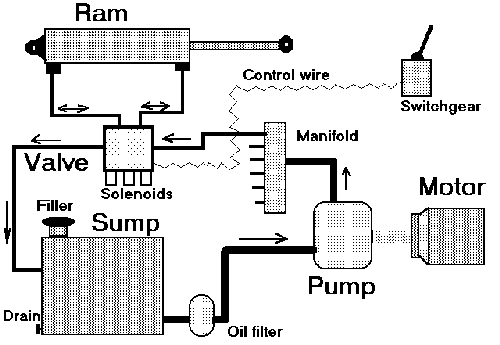
6.2 Hydraulic pumpsThe source of power in a hydraulics system is the pump. This takes hydraulic fluid from the sump/tank and raises it to a higher pressure. The fluid then circulates through the system, much in the same way as pneumatic systems. Like any other pump the hydraulic pump has an inlet pipe - this sucks hydraulic fluid in. The pistons or impellers in the pump then raise the pressure of this fluid, and it emerges at the fluid outlet (this is often the smaller of the pipes connected to the pump, and it is easily identifiable as the hottest if the pump is running). Caution must be exercised if you tamper with an operational pump - as with pneumatic systems if tampered with the high-pressure output from the pump could spray hot fluid over you, or burst/fail explosively. It is often easier, if the source of fluid is not accessible, to deal with the hydraulic control systems rather than take on the pump itself. As noted above, because of the higher pressures used in hydraulic systems, the components of that system tend to be incredibly well built. This is especially so for the pump. To disable a hydraulic pump is quite difficult - you must either remove its energy source (either an electric motor, electrical connection, or an engine), or you must try and take it apart. The latter can be very difficult. A third option would be to spike the fluid with abrasive, but this might not have a very quick effect. Typical hydraulic pumps (fig. 13/14)
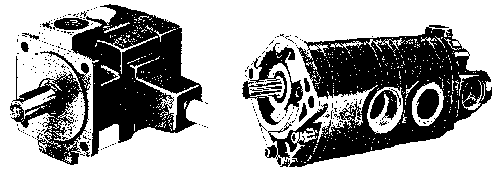 Manual valve and manifold (figure 15) and Electrical valve and manifold (figure 16)
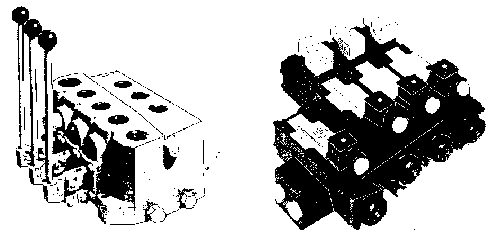 6.3 Valves and switchesDifferent types of hydraulic system have different types of control mechanism. At its simplest a system might comprise a sump, a pump, a ram (piston), and a 'changeover' switch which pumps fluid alternately to each end of the ram to move it back and forth. More complex systems may have one or more pumps, serving a large number of rams or hydraulic motors (similar to air motors). How the control systems are actuated can also differ; some are mechanical - you pull a lever to activate the valve; some are electrical - you press a button to activate the valve; and some are electromechanical - that is an electrical system might activate a road or cable which then pulls a lever which activates the valve. How you tackle these different control systems will depend upon the target. Mechanical systems can be dismantled. Breaking them is very difficult because they are normally made from cast metal bolted together with high-tensile steel bolts. Electrical systems are simpler - the electrical connections are vulnerable, and the control panel itself may be easily modified. Normally the electrical part of the valve is in a separate housing on the top or side of the valve, and is often less sturdily built - in these cases more direct action against the valve is possible. Electromechanical systems are difficult to explain, because they differ so widely. Tackling them is really a combination of the two approaches outlined above - you tackle both the electrical sections of the system and the mechanical parts. Whatever the switching system, all valves will be connected to some sort of 'manifold', where oil under pressure is distributed to different parts of the hydraulic system. Often the manifold is part of/located beneath the main switches. Damaging the manifold, or removing the valves from it, is therefore a sure way of disabling the whole system. Construction and designs of hydraulic hoses and hydraulic connectors (figures 17-20)
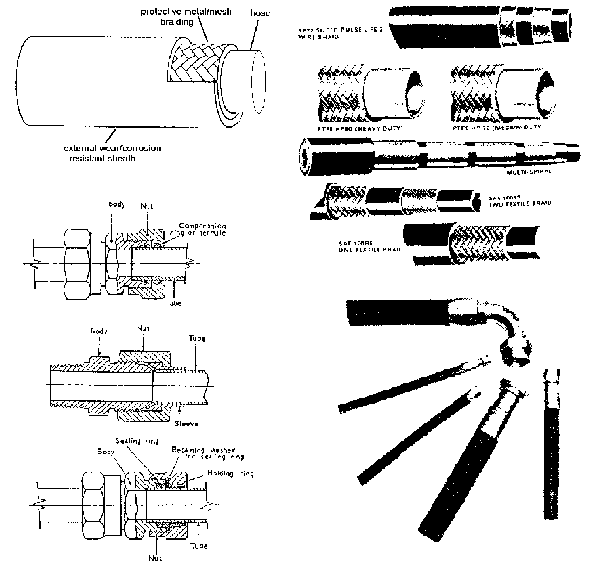 6.4 PipesOne of the needs in the hydraulic system is to move energy - the oil under pressure - to where it is needed. This is done using two types of pipe: There are two basic options for sabotage - you either cut or drill. Cutting can be difficult, particularly with large heavy metal pipes. Likewise drilling can be also difficult on reinforced/armoured hoses. With hoses there is another option though - you can unscrew them. Generally hoses have metal screw connectors on each end - most of these can be easily unscrewed if you have a spanner big enough for the job. Of course just removing a hose does not cause a lot of damage, so often the most effective method is to remove the hose (carefully plugging the holes to stop too much fluid leaking out), fill the hose with an abrasive such as sand, iron filings or small steel screws, and then replace the hose. Cutting larger pipes and hoses can be time consuming - although small hoses may cut easily with bolt cutters, or good side cutters. In these instances you might consider drilling the pipe/hose with the small (2mm) drill - the end result is that the owner of the equipment will have to replace the part, which saves you the job of removing it yourself. Be aware that metal pipes can be welded up, so if you do drill metal pipes make a few holes, or better still, drill the hole right on the side of a screw fitting or joint of some kind (this makes welding more difficult as it affects the use of the screw fitting). Typical hydraulic ram (figure 21)
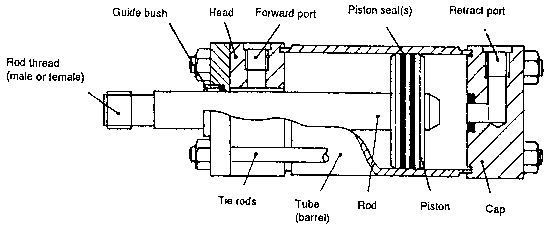 6.5 RamsHydraulic rams do the actual 'work' in hydraulic systems - thus because they must withstand great stress they tend to be extremely well built, much more so than air cylinders. In general I would say that it's not worth taking on a hydraulic ram if you are short or time - it's much quicker to just go for the pump, sump or pipes. However, it you do have time you could try drilling through the ram casing/tube, or trying to damage/remove the end bush. Another option is to remove the flexible hoses and swap them around, or remove the pipe/hose, inject abrasive materials into the ram, and then replace the pipe. Don't forget also Newton's Third Law of Motion - 'for every action there is an equal and opposite reaction'. The hydraulic ram must be fixed to something in order to anchor it. If you can undo these fixings so that the ram is not anchored to anything, it doesn't do its job. 6.6 Sump and fluidPerhaps the greatest flaw of the hydraulic system is its need for oil - but unfortunately oil is relatively cheap so depriving the system of oil has no great long term effect. Also, removing oil can have serious environmental consequences. So we have to work in ways which eliminate/minimise the spill of oil, but still render the system unusable. This essentially means finding ways to contaminate the oil to make it useless. There are three straightforward methods... The only thing to beware is that when fiddling with the sump, try not to splash too much fluid on your skin, or more crucially, in your eyes. Some people have a sensitivity to the substances in the hydraulic fluid which brings them out in a rash, and getting oil in your eyes can cause serious damage. 6.7 Basic sabotage of hydraulic systemsHow you tackle a system depends on what it is, where it is, and most importantly how much time you have... Also you must think of 'quality'. Take a few minutes to study the system and work at which hoses connect to what, or which control systems actuate what ram. That way you can tackle the most crucial parts of the system. Another thing to consider is whether the system is active or not, and whether, even if the system is turned on, the pipes/hoses are under pressure due to gravity. An associate was mildly hurt when cutting the hose on a JCB - the jib of the JCB was raised, and the oil in the pipe held the jib up against gravity. When the hose was cut, the jib came down - very quickly! Likewise, cutting a pipe/hose in an active system can be very dangerous, if not because of the effect on the system, then because of the hot oil under pressure it sprays out in every direction. In volume I there is an illustration of how to drill pipes under pressure - this should only be attempted on small pipes you can be reasonable sure carry little pressure.
[Back to Contents]
[Go to next section]mailto:webmistress@sabotage.org goto:webmistress |